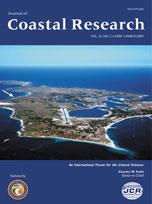This study investigates the application of the wave model (WAM) to simulate the generation and propagation of typhoon waves in Korean seas. The model solves the energy balance equation for wave growth based on wind energy input, and simulates spatial and time evolution of wave spectra. Although WAM has been extensively validated and used in various global and regional wave forecasts, its application to the simulation of typhoon waves has not been investigated thoroughly.
Crucial to the application of WAM in typhoon wave modeling is the specification of accurate wind input data and adequate resolution of the wind structure. This study compares and analyzes two different wind fields for the same event, viz., simulated wind field from a storm model and blended global QSCAT/NCEP winds. The simulation experiment was run for 4 days as Typhoon Olga (1999) approached the west coast of Korea. The results are compared with shallow water buoy observations as the typhoon was approaching landfall. The simulated significant wave heights in the open ocean were approximately 8.6 m, which gradually decreased as the typhoon approached shore. Olga was an intense typhoon, and its compact wind structure provides a unique test case to examine the required directional, frequency, and spatial resolution in WAM for modeling typhoon generated waves.





